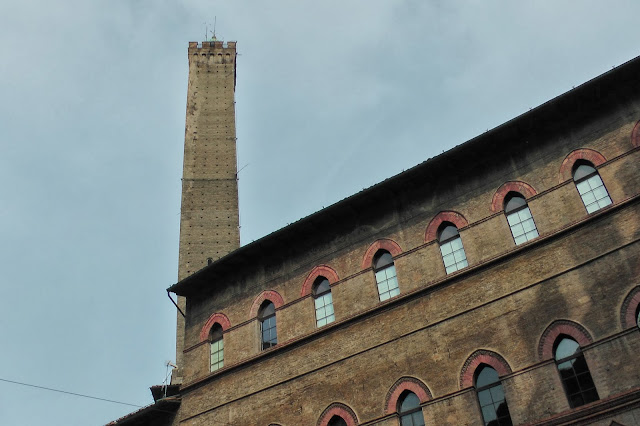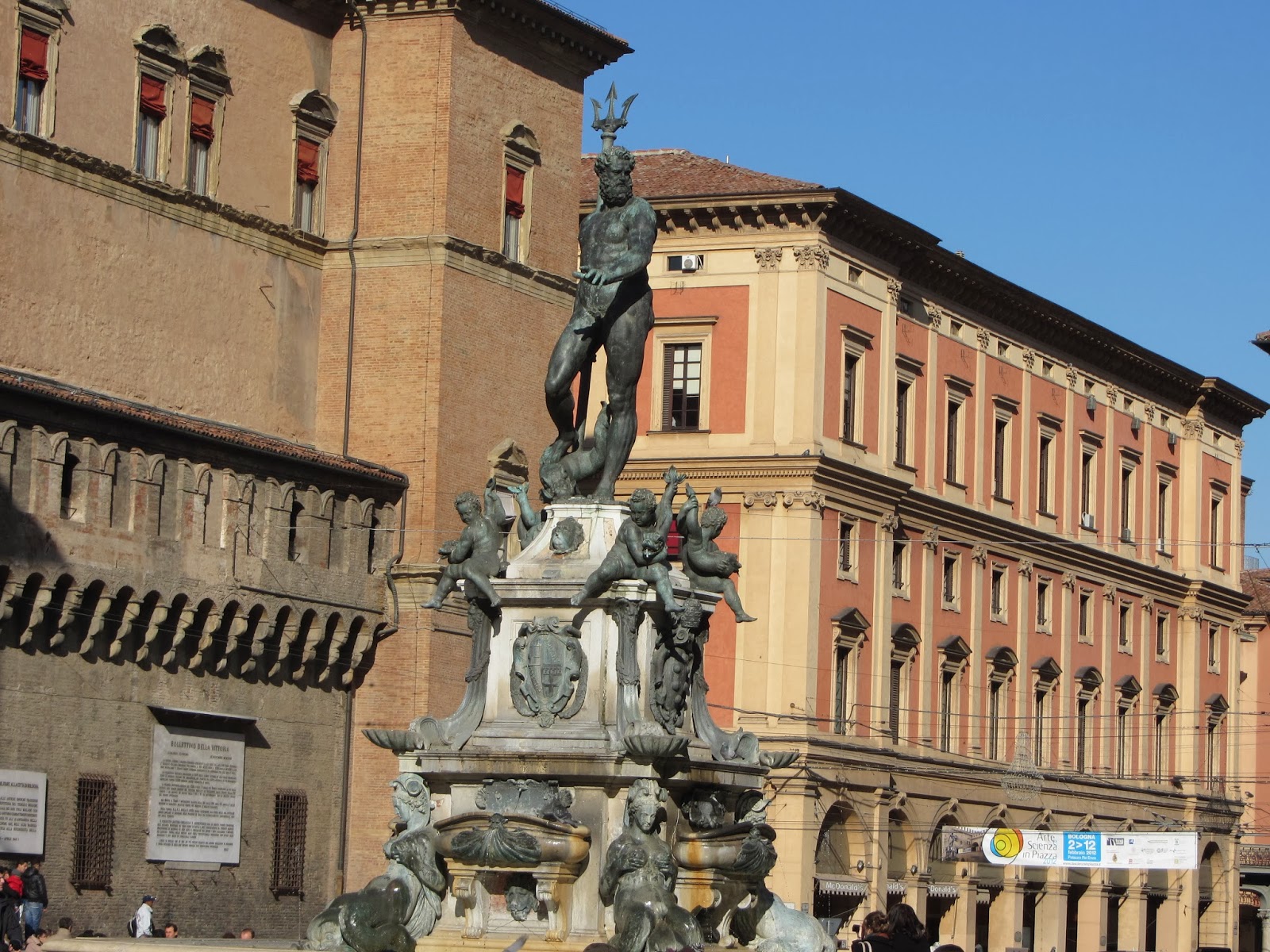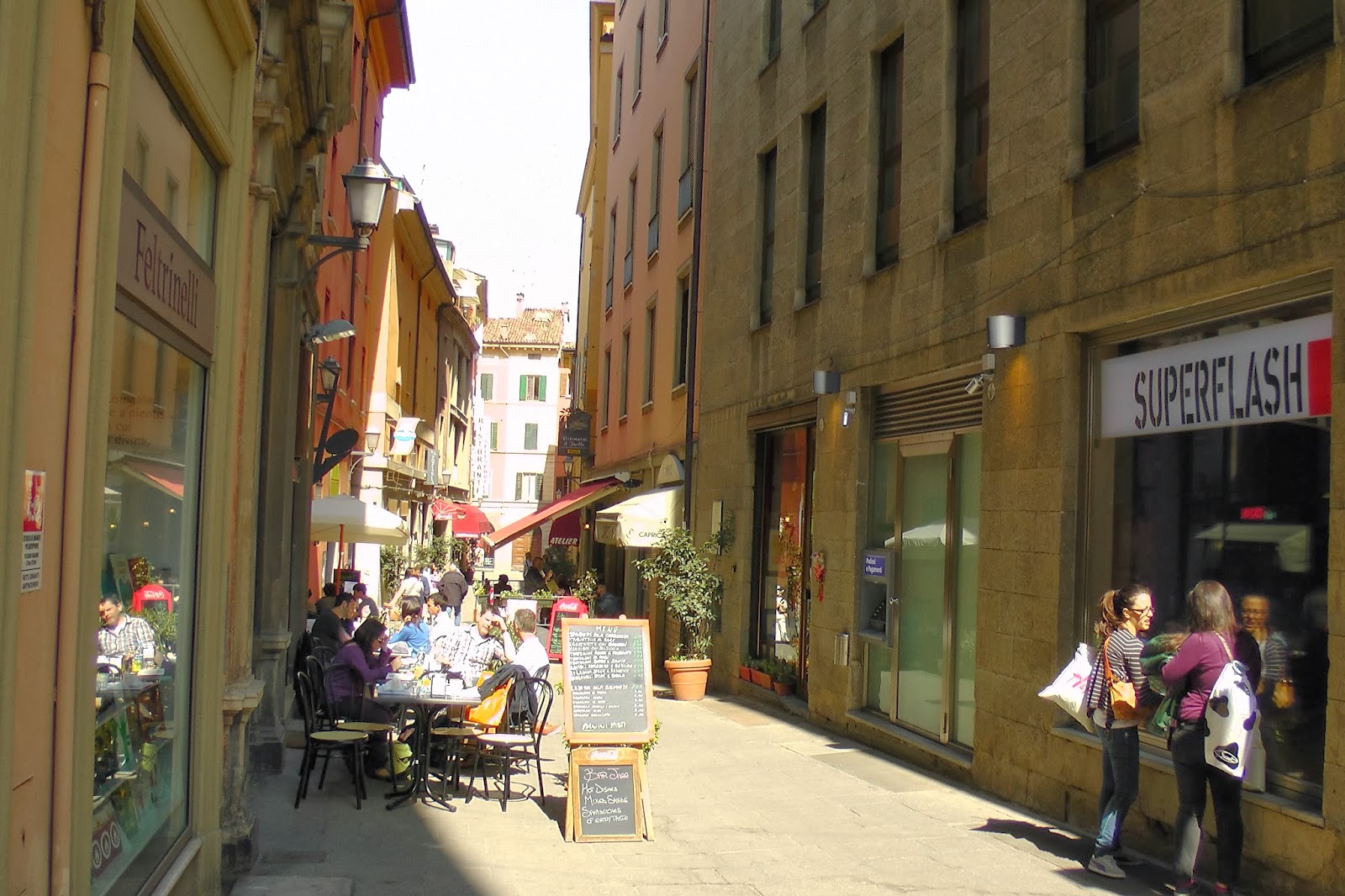Bologna lies in the Po Valley, in Northern Italy, about 400 km from the capital Rome. It has a population of about 400.000 inhabitants. It lies near the Reno river and is an important crossroads of the roads and trains of Northern Italy. Because of its importance as a train hub, it was bombarded many times during World War II.
Bologna is the heart of a wealthy metrolitan area, which owes its prosperity to many important mechanical, electronic, and nutritional industries, which have their headquarters in this area. It has also an important fair district. Fairs as Cersaie, for building industry, and the fair of shoes attract thousands of people, not only from Italy but also from Europe.
Bologna has a green heart, the Margherita Gardens, which are located near the center; in the outskirts there is the agreeable Saragozza quarter, which climbs towards adjacent Hills. The city has always been an important urban center, first under the Etruscans, then under the Romans, then again in the Middle Ages, as free municipality. Bologna has been for many centuries the second city of the Papal States, after Rome; consequently it has many important churches, like San Petronio, san Francesco, Santo Stefano, and San Domenico. There are many important landmarks, such has the two medieval towers, lengthy porticoes, antique buildings, the layout of the historical center, which is one of the largest in Italy, in spite of demolitions at the end of the 19th century and bombardments during the second war.
Above all, Bologna is famous for its University, which was founded in 1088 and is considered the oldest in the world; therefore it is called "the learned" (la dotta). It hosts thousands of students who enrich the social and cultural life of the city. But grinding away at study is more tolerable after a good meal. It is easier to come up with brilliant ideas after a good meal. So, Bologna is also famous for its excellent cookery. Therefore it is also called "the fat" (la grassa). Bologna is also home to other universities such as the Bologna Centre of John Hopkins University.
-----------------------------------------------------------------------------
In 1256, Bologna promulgated which
abolished feudal serfdom and freed the slaves (with the "Paradise Law"). At that time
there were perhaps 180 towers. In 1270 Bologna's
politics was dominated by Luchetto Gattilusio, a Genoese diplomat and man of letters who became the city Governor. Like in most Italian cities of
that age, in Bologna the Guelph and Ghibelline factions struggled against each other; this led to the expulsion of the Ghibelline family of the
Lambertazzi in 1274.
From 1401 Bologna was ruled by the Bentivoglio family, first with Sante (1445–1462) and then under Giovanni II (1462–1506). This was a flourishing period for the city and the
presence of notable architects and painters made Bologna a true city of
art.The School of Bologna of painting
flourished in Bologna between the 16th and 17th centuries, and rivalled
with Florence and Rome as the centre of painting.
In 1506 the Papal troops of Julius II besieged Bologna and sacked the artistic treasures of the Bentivoglio palace. From that year
on, until the 18th century, Bologna was part of the Papal States and was ruled by a
cardinal legato and by a Senate which every two months elected a "gonfaloniere"
(judge), assisted by eight elder consuls. In 1530, in front of Saint Petronio Church, Charles V was crowned Holy Roman Emperor by Pope Clement VII.
--------------------------------------------------------------------------------------------
Between the 12th and the 13th century, the number of towers the city was very high, possibly up to 180. The reasons for the construction of so many towers are not clear. One hypothesis is that the richest families used them for offensive/defensive purposes. During the 13th century, many towers were taken down or demolished, and others simply collapsed. Many towers have subsequently been utilized in one way or the other: as prison, city tower, shop or residential building. The last demolitions took place during the 20th century, according to a restructuring plan for the city.
The construction of the towers was quite onerous, the usage of serfs notwithstanding.
To build a typical tower with a height of 60 m would have required between
three and 10 years of workEach tower had a square cross-section with
foundations five and ten m deep, reinforced by poles hammered into the ground
and covered wit hpebble and lime. The tower's base was made of big blocks ofselenite
stone. The remaining walls became successively thinner and lighter the higher
the structure was raised, and were realised in so-called "a sacco "
masonry: with a thick inner wall and a thinner outer wall, with the gap being
filled with stones and mortar.
Of the numerous towers originally present, fewer than twenty can still be seen today. Among the remaining ones are the Azzoguidi Tower, also called Altabella (with a height of 61 m), the Prendiparte Tower, called Coronata (60 m), the Scappi Tower (39 m), Uguzzoni Tower (32 m), Galluzzi Tower, and the famous Two Towers: the Asinelli Tower (97 m) and the Garisenda Tower (48 m).
The Two Towers are located at the intersection of the roads that lead to the five gates of the old ring wall (mura dei torresotti). The taller one is called the Asinelli while the smaller but more leaning tower is called the Garisenda.
Bologna is famous for its towers and has a well-preserved historical centre (one of the largest in Italy) thanks to a careful restoration and conservation policy which began at the end of the 1970s.
The
Azzoguidi Tower
The
Prendiparte Tower
Vista di Bologna dalla torre Asinelli - Foto di Goldmund100 (Luca Volpi) - Creative Commons Attribution-Share Alike 3.0 unported license
Sights of the Torre del Podestà
Palazzo d'Accursio
The fountain of Neptune
The Fountain of Neptune is a monumental
civic fountain located in the square with the same name, Piazza
Nettuno, next to Piazza Maggiore. The bronze figure of Neptune
is an early work of the maturity of Giambologna and was
completed about 1567. Neptune extends his reach in a gesture of stilling and controlling the sea waters.
Palazzo del Podestà
Piazza Maggiore was created in its present appearance in the 15th century
Palazzo d'Accursio seen from via Ugo Bassi
Palazzo della Mercanzia (Loggia dei Mercanti)
La Porta Magna
San Petronio
San Domenico
The Basilica
of Saint Francis is a historic church founded in the 13th
century; it has been the property of the Conventual Franciscan friars since then.
Santo Stefano's Basilica is a complex of religious edifices located in the eponymous square; it is locally known as Sette Chiese ("Seven Churches") and Santa Gerusalemme ("Holy Jerusalem").
According to tradition, it was built by Saint Petronius, who was bishop of the city during the 5th century, over a temple of the goddess Isis. The church of St. John the Baptist (or of the Holy Crucifix) dates from the 8th century, while that of the Holy Sepulchre from the 5th, as well as that of San Vitale ed Agricola. A 13th-century portico known as Pilate's Courtyard connects the other buildings to the church of the Holy Trinity (13th century).
Bologna Cathedral ( Cattedrale
Metropolitana di San Pietro),
dedicated to Saint Peter. It is the seat of the Archbishop of Bologna.
There was already a cathedral on the site (on the present Via Indipendenza)
in 1028, accompanied by a pre-romanesque campanile with a circular base. This church was
destroyed by a devastating fire in 1141. It was reconstructed, and consecrated
byPope Lucius III in
1184.
By order of Cardinal Gabriele Paleotti a radical remodelling of the
interior of the building began in 1575; only the crypt
and the Greater Chapel (Capella Maggiore) survive. Because of the extensive alterations the vaults collapsed in 1599; so the
decision was then made to rebuild the main part of the cathedral from scratch.
Work on the new building started in 1605. A new façade was added between 1743
and 1747, which was designed by the architect Alfonso Torreggiani,
on the instructions of Pope Benedict XIV.
Portico del Pavaglione
The cityscape is enriched by its elegant and extensive porticoes, for which the city is famous. In total, there are some 38 kilometres of porticoes in the city's historical centre, which make it possible to walk for long distances sheltered from the elements.
Ancient porticoes with wood columns
A courtyard of the University
Today the seat of the University is in via Zamboni 33
In the Napoleonic era, the headquarters of the university were moved to their present location on via Zamboni, in the north-eastern sector of the city centre. Today, the University's 23 faculties, 68 departments, and 93 libraries are spread across the city. Noteworthy students present at the university in centuries past included Dante, Petrarca, Thomas Becket, Erasmus of Rotterdam and Copernicus. In more recent history, Luigi Galvani, the discoverer of biological electricity, and Guglielmo Marconi, the pioneer of radio technology, also worked at the University.
---------------------------------------------------------------------------------------
In the Napoleonic era, the headquarters of the university were moved to their present location on via Zamboni, in the north-eastern sector of the city centre. Today, the University's 23 faculties, 68 departments, and 93 libraries are spread across the city. Noteworthy students present at the university in centuries past included Dante, Petrarca, Thomas Becket, Erasmus of Rotterdam and Copernicus. In more recent history, Luigi Galvani, the discoverer of biological electricity, and Guglielmo Marconi, the pioneer of radio technology, also worked at the University.
---------------------------------------------------------------------------------------
The University of Bologna, founded in 1088, is the oldest existing university in the world, and was an important centre of European intellectual life during theMidle Ages, attracting scholars from throughout Christendom. A unique heritage of medieval art, exemplified by the illuminated manuscripts and jurists' tombs produced in the city from the 13th to the 15th centuries, provides a cultural backdrop to the renown of the medieval institution. The Studium, as it was originally known, began as a loosely organized teaching system with each master collecting fees from students on an individual basis. The location of the early University was thus spread throughout the city, with various colleges being founded to support students of a specific nationality.
Courtyard of the 16th-century Archiginnasio, historical seat of the University of Bologna
Anatomical theatre of the Archiginnasio, dating from 1637
Interior of the Archiginnasio with the Coats of Arms of the students
The Jurists' tombs
Palazzo Pepoli
In 1337, the rule of the noble Pepoli family, nicknamed by some scholars as the "underground nobles" as they governed as "the first among equals" rather than as true nobles of the city.
Palazzo Pepoli
In 1337, the rule of the noble Pepoli family, nicknamed by some scholars as the "underground nobles" as they governed as "the first among equals" rather than as true nobles of the city.
Il "cuore quadrato"
L'antica bottega
Osteria del sole
Ancora oggi, qui, si passeggia tra storiche botteghe passate di generazione in generazione, veri e propri tesori artistici che conservano intatti gli arredi e l’architettura di un tempo. Ecco allora, tra piazza Re Enzo e il portico del Voltone del Podestà, La Torinese 1888, famosa per la cioccolata in tazza, la gelateria artigianale e la pasticceria. Su via degli Orefici, gli spazi recuperati del cinema Ambasciatori accolgono la sede di Eataly che, in uno spazio storico mette in scena una formula contemporanea di intrattenimento che mescola cultura e offerta enogastronomica. Poco più in là c’è La Bottega del Caffè, della famiglia Filicori, specializzata da tre generazioni nella torrefazione e nella vendita di dolciumi, cioccolato, liquori, tè e coloniali. Tra via degli Orefici e via Pescherie Vecchie, vicolo Ranocchi ospita non solo l’omonima Polleria Ranocchi attiva da più di cinquant’anni, ma anche l’iconica Osteria del Sole, la più antica di Bologna, dove ancora oggi si viene per bere del buon vino da accompagnare a pane, formaggi e affettati acquistati in una delle botteghe circostanti o nel vicino Mercato di Mezzo. Ritornando su via delle Pescherie Vecchie ecco la Pescheria del Pavaglione, perfetta per una sosta di gusto a base di piatti marinari e pesce crudo. Sempre qui un bel frontone in marmo con insegna in rilievo distingue da oltre mezzo secolo la Macelleria Equina, mentre in strada spiccano i banchi ben forniti di pesce della Pescheria Brunelli, già friggitoria dal 1924.
A typical lane in the center of the city
Canals seen from via Piella
Pope Benedetto XIV (cardinal Lambertini)
"Il compianto del Cristo morto" by Niccolò dell'Arca in Santa Maria della Vita
Giovanni Bentivoglio e Ginevra Sforza, signori di Bologna (opera di Giuseppe Romagnoli)
Aerial view of the city
MY HOUSE
Chiesa del Suffragio
RISTORANTI E BOTTEGHE
NEGOZIO ATTI
See also:
BOLOGNA - ALMA MATER STUDIORUM
http://johncristiani.blogspot.it/2012/10/bologna-alma-mater-studiorum.html
BOLOGNA VISTA DALL'ALTO
http://johncristiani.blogspot.it/2016/03/bologna-vista-dallalto.html















.jpg)




































































Nessun commento:
Posta un commento